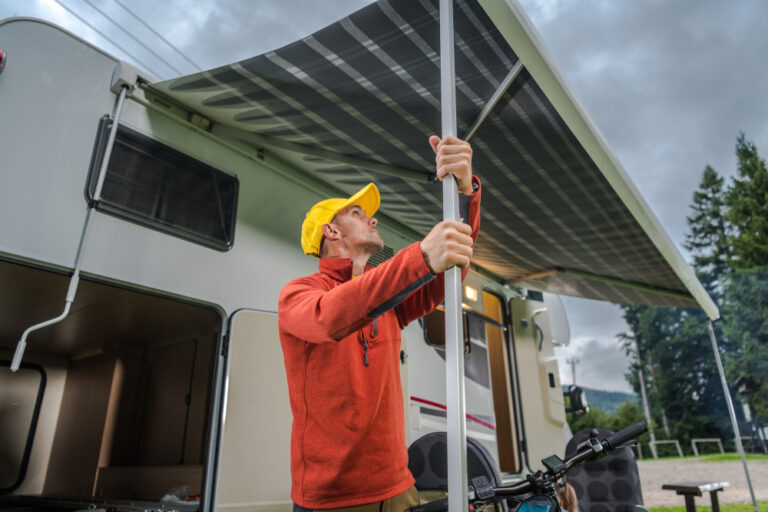
Arriving at a new campsite brings excitement and the need for safety. To ensure a smooth and secure stay, it’s essential to follow a routine security checklist. In this guide, we’ll cover key strategies like choosing a safe location, setting up your RV properly, maintaining campground safety, and coexisting with wildlife. These tips will help make your RV adventure with RVshare both secure and enjoyable.
Establishing Your Secure Base at an RV Campsite
When setting up your RV campsite, choose a level area free from hazards like holes or debris to ensure stability and reduce the risk of accidents. Avoid sites near cliffs or steep slopes to prevent dangerous situations, and assess drainage to avoid flooding from rainstorms. Opt for locations with natural windbreaks, such as bushes or low trees, to protect against strong winds. These considerations will help ensure a safe and enjoyable RV camping experience.
Mastering the Set-Up: The Essentials of RV Placement and Stabilization
To ensure a safe RV campsite, start by parking on a level surface, using leveling blocks—if needed—to stabilize your rig and keep appliances like your refrigerator functioning properly. Stabilizer jacks are also essential, as they keep your RV steady and prevent movement from factors like entering and exiting or strong winds. Additionally, wheel chocks should be placed on both sides of your tires to prevent rolling.
Also, maintain a safe distance of at least 15 feet from fire pits or grills to avoid potential fire hazards from sparks or embers. These precautions will help create a secure and comfortable environment for your RV camping experience.
Essential Items for a Safe RV Set-Up:
- Leveling blocks
- Stabilizer jacks
- Wheel chocks
- Fire extinguisher
- Reflective safety gear
Keeping Things Tidy: Tips for Preserving Campground Security
Ensuring a safe RV camping experience involves proper parking and effective space management. Using reflective tape or glow sticks to mark guy lines and tent stakes helps prevent tripping and improves site security.
Maintaining a clutter-free environment enhances your RV travel experience. Neatly store gear, secure loose items like awnings, and keep your campsite organized to reduce tripping hazards and prevent equipment damage.
Coexisting with Nature: Preventing Wildlife Encounters
One crucial aspect often overlooked when setting up a safe RV campsite is the interaction with local wildlife. The allure of nature is undeniable, yet it comes with the responsibility to maintain a harmonious existence with the surrounding fauna. Here’s how you can secure your spot without inviting unwanted animal guests.
Proper Food Storage: The first step toward a wildlife-proof campsite is meticulous food storage. Utilize airtight containers and ensure that all your meals and snacks are stored securely inside your RV or in designated bear-proof lockers available at many campsites. This practice not only protects your food but also keeps curious critters at bay.
Regular Trash Disposal: Always dispose of garbage promptly in bear-proof dumpsters, if available. Accumulating trash can quickly turn your campsite into a hotspot for wildlife encounters. Regular disposal helps minimize odors that attract animals and maintains the cleanliness of your camping area.
Maintaining Campsite Cleanliness: Beyond securing food and managing waste, keeping your site tidy is imperative. Ensure that no food scraps or dirty dishes are left out, as they can attract wildlife from miles away. A clean campsite is less likely to become a target for wandering wildlife looking for an easy meal.
Following these simple yet effective guidelines can significantly reduce the chances of wildlife encounters at your RV campsite. By proactively managing how you store food, dispose of waste, and maintain cleanliness, you contribute not only to the safety of your group but also to the well-being of the local wildlife population.
Campground Safety FAQs
1. What is the best way to level your RV at a campsite?
Ensuring a safe RV campsite begins with proper leveling to stabilize your vehicle and prevent strain. Use a bubble level or electronic system to check the ground’s evenness, then place leveling blocks or jacks under the lower side as needed. Proper leveling helps appliances run efficiently and reduces the risk of doors swinging unexpectedly.
2. How do I secure my awnings and gear against the wind at an RV campsite?
During your RV travel, sudden winds can pose a risk. Secure your awning with tension straps and stakes, ensuring that they are tightly fastened to handle unexpected gusts. For additional gear like chairs and tables, use weighted anchors or tie them down to fixed points. This precaution not only protects your equipment but also maintains a clutter-free area around your campsite.
3. Where should I store my food to minimize attracting wildlife?
Storing food correctly is crucial to maintaining campground security and preventing wildlife encounters. Use airtight containers and store all food items inside your RV or in designated bear-proof containers if you’re camping in bear country. Avoid leaving food out overnight or unattended on picnic tables to keep curious animals at bay.
4. How can I safely dispose of waste at an RV campsite?
Proper disposal of waste is essential for maintaining a safe RV campsite. Always use designated disposal sites for both garbage and sewage. Ensure all trash is placed in wildlife-proof dumpsters, if available. Regular disposal not only helps maintain cleanliness but also reduces the chances of attracting animals to your site.
5. What should I do if I encounter wildlife near my campsite?
If you encounter wildlife near your campsite, it’s important to stay calm and not approach or feed the animals. Observe from a distance and ensure that all food sources are securely stored away. If an animal appears aggressive or is too close for comfort, slowly retreat to your RV and alert the campground management.






